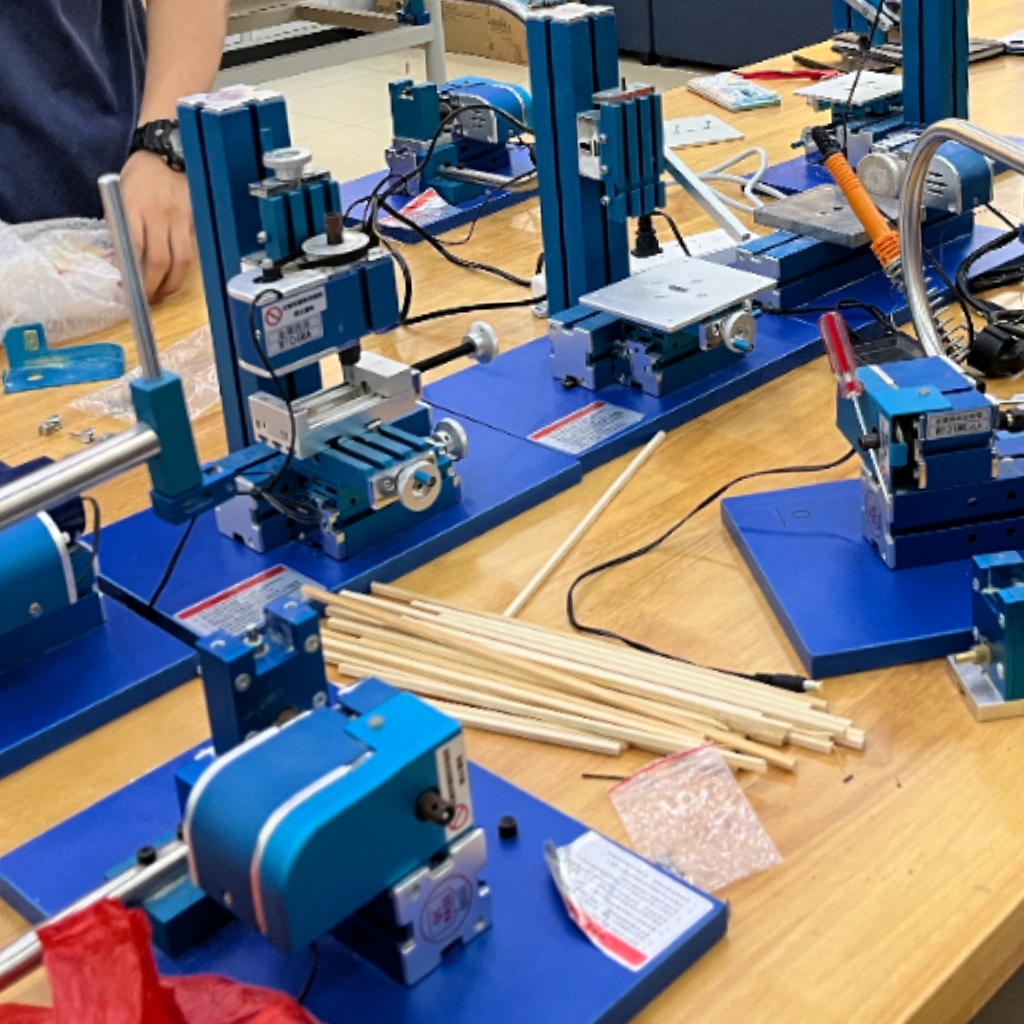Blog
Xendoll has 22 years of experience in the production of small machine tools. We will help you choose the suitable machine and share our experience in CNC machining with you.
 Jun 13, 2025
Jun 13, 2025

 712
712
The whirring of the spindle, the bite of metal on metal – the lathe is a cornerstone of machining. Whether you're a hobbyist crafting a unique piece, an educator demonstrating precision manufacturing, or a professional setting up a workshop, having the right tools is paramount. A common question, especially for those starting out or exploring possibilities, is:Can you use normal chisels on a lathe? The short, unequivocal answer is generally no, and it's strongly discouraged for safety and performance reasons. Let's delve into the critical differences and why specialized lathe tools are non-negotiable for successful turning.
Why "Normal Chisels" Fall Short on the Lathe
"Normal chisels" typically refer to tools designed for hand use, like woodworking chisels (for paring or chopping wood) or cold chisels (for cutting or chipping cold metal). While they might share a superficial resemblance to some lathe tools, their fundamental design, material, and intended use make them perilously unsuitable for powered lathe work:
Material Composition & Hardness:
Wood Chisels: Usually made from high-carbon steel, hardened to withstand hand mallet blows and wood cutting. However, they lack the extreme hardness and heat resistance required for the high-speed friction and heat generated when cutting metal or even dense wood on a lathe. They will dull rapidly, overheat, and potentially lose their temper (softening), rendering them useless quickly.
Cold Chisels: Designed for impact (hitting with a hammer), not continuous cutting. They are relatively tough but not hard enough to maintain a sharp edge against spinning metal or wood for long. Using them on a lathe will cause immediate, severe blunting.
Lathe Tools: Crafted from High-Speed Steel (HSS) or Carbide. HSS retains hardness at high temperatures generated during cutting. Carbide inserts are even harder and more heat-resistant, allowing for sustained cutting action without rapid dulling. This is essential for efficiency and surface finish.

Tool Geometry & Cutting Action:
Clearance Angles: Essential to prevent the tool's flank from rubbing against the spinning workpiece, which causes friction, heat, poor finish, and tool damage.
Rake Angles: Control how the tool engages and lifts the chip away. Positive rake angles reduce cutting force but may sacrifice edge strength; negative rake angles offer stronger edges for harder materials. Hand chisels simply don't have these optimized angles for powered rotation.
Cutting Edge Profile: Turning tools come in specific shapes (round nose, parting, threading, facing, boring tools) each designed for a precise operation. A standard chisel has a single, general-purpose edge.
Hand Chisels: Designed for scraping, paring, or impact shearing. Their cutting angles (rake and clearance angles) are optimized for slow, hand-guided force in specific directions. They lack the complex, precisely ground geometries needed to efficiently shear material away from a rotating workpiece.
Lathe Tools: Feature specific, carefully ground geometries:
Shank Design & Rigidity:
Hand Chisels: Have relatively thin, often tapered, tangs designed for fitting into wooden handles. They lack the massive, rigid shank needed to be securely clamped in a lathe tool post.
Lathe Tools: Feature thick, robust, and consistently sized shanks (often square or rectangular) that fit snugly into the tool holder. This rigidity is critical to prevent chatter (vibration that ruins surface finish), tool deflection (causing inaccurate cuts), and, crucially, catastrophic tool failure or ejection.
Safety: The Paramount Concern
This is the most critical reason to avoid "normal" chisels:
Ejection Hazard: The inadequate shank and clamping can cause the chisel to be violently ripped from the tool post by the rotating workpiece.
Shattering Hazard: Hardened steel like that in wood or cold chisels can be brittle. The high forces and potential impacts on a lathe can cause the tool to shatter, sending sharp fragments flying at high speed.
Catch-and-Throw Hazard: If the tool digs in or catches unexpectedly (much more likely with improper geometry), the workpiece or part of it can be torn from the lathe chuck.
Operator Instability: Trying to hold a hand chisel freehand against a powered lathe is incredibly dangerous and unstable, greatly increasing the risk of hand injury.
Lack of Control: Improper geometry leads to poor cutting action, increased cutting forces, and unpredictable tool behavior, significantly raising the accident risk.
The Right Tools for the Job: Lathe Cutting Tools
So, what should you use? Lathes require purpose-built cutting tools:
High-Speed Steel (HSS) Tool Bits: The versatile workhorses. Sold as solid blanks (typically 1/4", 3/8", or 1/2" square shank), they are ground by the user to specific shapes (round nose, left/right hand, parting, threading) using a bench grinder. They offer excellent toughness, can be resharpened many times, and are cost-effective for diverse tasks.
Indexable Carbide Insert Tooling: Feature a durable steel shank with a pocket that holds a small, replaceable carbide cutting tip (insert). When one edge dulls, you simply rotate or index the insert to a fresh edge. Offers high productivity, consistent performance, and eliminates the need for grinding. Ideal for harder materials and production work.
Brazed Carbide Tools: A solid shank with a carbide tip brazed (soldered) onto the end. Less common than HSS or indexable now, but still used for specific applications. Sharpenable, but carbide requires diamond wheels.
Specialized Tool Holders: These securely clamp the tool bits or inserts and provide precise height and angle adjustment relative to the workpiece centerline. Common types include quick-change tool posts, rocker tool posts, and dedicated holders for specific insert types.

What If You Absolutely Must Improvise? (Proceed with Extreme Caution!)
While strongly discouraged, if circumstances are extremely limited and only for light, non-critical work on SOFT WOOD (never metal!), and you accept the significant risks:
Grind Your Own from HSS Blank: This is the only remotely safe approach. Purchase a proper HSS lathe tool blank (like those offered by Xendoll Tools) and grind it to the required shape using a bench grinder, following safe grinding practices and reference geometry guides. You are creating a real lathe tool, not misusing a hand chisel.
Rigorous Clamping: Ensure any tool used has a thick, rigid shank securely clamped in a proper tool holder, positioned at or slightly below center height.
Minimal Cuts: Take very light cuts at slow speeds.
Never Use Hand-Held: Under no circumstances attempt to hold a chisel freehand against a powered lathe.
PPE is Mandatory: Full-face shield, safety glasses underneath, close-fitting clothing, no gloves near rotating parts.
Conclusion: Safety and Performance Demand the Right Tools
The question "Can you use normal chisels on a lathe?" has a clear and critical answer: NO. The material limitations, incorrect geometry, inadequate rigidity, and, most importantly, the severe safety hazards make it an extremely dangerous and ineffective practice. Lathes are powerful machines that demand respect and the correct, purpose-engineered cutting tools – High-Speed Steel (HSS) blanks ground to shape, indexable carbide insert tooling, or brazed carbide tools – securely mounted in appropriate holders.
Investing in proper lathe tooling from reputable suppliers like Xendoll Tools isn't just about achieving a good finish or working efficiently; it's a fundamental requirement for operator safety and workshop integrity. Whether you're a machining enthusiast exploring new projects, an educator equipping a learning lab, or a distributor supplying professionals, prioritizing the right tools ensures successful, productive, and, above all, safe turning operations. Don't compromise – equip your lathe correctly. Explore Xendoll Tools' range of precision HSS blanks, tool holders, and accessories designed for the demands of mini-lathes and serious hobbyists.
For details, please refer to the following link:
https://www.xendolltools.com/category/micro-cnc-machine.html



 Show all our samples
Show all our samples
 Provide you with a free quote
Provide you with a free quote
 Answer all the questions you may have
Answer all the questions you may have
 Guided installation and other options
Guided installation and other options